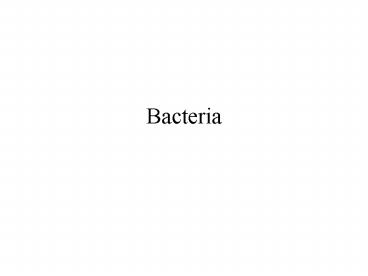Bacteria - PowerPoint PPT Presentation
1 / 18
Title:
Bacteria
Description:
... that inhabit extreme (very salty, hot, acidic, or low-oxygen) environments ... Staphylococcus a cluster of coccus bacteria. Escherichia coli rod-shaped bacteria ... – PowerPoint PPT presentation
Number of Views:49
Avg rating:3.0/5.0
Title: Bacteria
1
Bacteria
2
Characteristics
- Most primitive organisms on Earth
- Microscopic
- Prokaryotic no nucleus or organelles, except for
ribosomes - Unicellular
- Have a single, circular molecule of DNA
3
Characteristics (cont.)
- Tend to live as colonies/clusters or
filaments/strands of cells - Reproduce primarily asexually by binary fission
reproduce very quickly - No mitosis
- Most are surrounded by a cell wall, which is
composed primarily of peptidoglycan - Some have additional outer protective coverings
- Some have flagella
4
Classification
- Archaebacteriaprimitive bacteria that inhabit
extreme (very salty, hot, acidic, or low-oxygen)
environments - Cyanobacteriablue-green algae
- Eubacteriatrue bacteria
5
Archaebacteria
- Methanogensthe most common type of
archaebacteria - Anaerobic bacteria found in sewage, swamps, and
the digestive tracts of humans and other animals - Produce methane gas as they decompose organic
material
6
Cyanobacteria
- Ex. Anabaena, Oscillatoria, Gleocapsa
- Found in damp or wet areas (ponds, lakes, oceans,
pools, puddles, moist soil) and extreme
environmental conditions - Most are blue-green in color, but some are not
- All contain chlorophyll and can carry out
photosynthesis (photosynthetic autotrophs) the
chlorophyll is located within the cytoplasm or
plasma membrane
7
(No Transcript)
8
Cyanobacteria (cont.)
- Some go into a period of dormancy during adverse
environmental conditions - These cells can remain dormant until conditions
improvesometimes for years - Some secrete a gel-like protective coating around
the cell wall
9
Cyanobacteria (cont.)
- Many cyanobacteria fix nitrogen, or serve as
natural fertilizers by converting nitrogen in the
soil to a form that is usable by plants - Some have relationships with other organisms
(symbiosis) they may live inside another
organism in a parasite/host relationship they
may live with another organism in a relationship
whereby both organisms benefit, called mutualism
(as in lichens)
10
Eubacteria
- True bacteria
- Found almost everywhere
- Classified by shape
- Coccusspherical
- Bacillusrod-shaped
- Spirillumspiral-shaped
11
coccus
bacillus
spirillum
in-text, p. 313
12
Eubacteria (cont.)
- Generally heterotrophs, organisms that cannot
produce their own food by photosynthesis some
are decomposers, which break down dead organisms
and/or wastes others are parasites, which live
in or on a host some live in or on another
organism, but do not harm it - Some bacteria carry out chemosynthesis, a
process by which they make their own food without
sunlight and with different chemical substances
than in photosynthesis
13
Eubacteria (cont.)
- Most bacteria are aerobic, which means that
they require oxygen for cellular respiration
(which occurs using the plasma membrane, since
there are no mitochondria) - Some bacteria are anaerobic, which means that
they do not require oxygen for cellular
respiration
14
Eubacteria (cont.)
- Gram staina staining procedure used to
classify bacteria based on their cell wall
composition one of many tests used to help in
the identification of bacteria - Gram positive bacteriahave cell walls that
consist of a thick layer of peptidoglycan absorb
the stain well during the Gram staining
procedure appear purple under the microscope - Gram negative bacteriahave cell walls that
consist of a thin layer of peptidoglycan and an
outer layer of lipid do not absorb the stain
well appear pink under the microscope
15
Eubacteria (cont.)
- Antibiotics, chemical substances that can kill
cells, are more effective against Gram positive
bacteria than Gram negative - Many antibiotics work by interfering with cell
wall synthesis - Some bacteria contain DNA that is involved with
antibiotic resistance other bacteria can become
dormant during times of adverse environmental
conditions
16
Discovery of Bacteria
- Leeuwenhoek was the first to see and describe
bacteria (1600s) - Pasteur was the first to study the relationship
between bacteria and diseases he developed
pasteurization, which is a process involving the
gentle heating of a solution to kill the bacteria
in it
17
Bacteria and Disease
- Pathogensdisease-causing organisms such as
bacteria - Diseases/Conditions caused by bacteria
- Strep throat Ear infections
- Tetanus Tuberculosis
- Anthrax Dental Cavities
- Lyme Disease Food Poisoning
- Venereal Disease Boils
- Acne Rocky Mtn. Spotted Fever
18
Bacteria and Disease (cont.)
- Examples of specific disease-causing bacteria
include - Streptococcusa chain of coccus bacteria
- Staphylococcusa cluster of coccus bacteria
- Escherichia colirod-shaped bacteria































